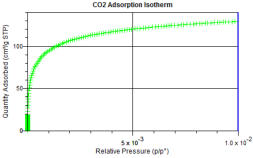




Expertise in the Physical
Characterisation of Materials

MCA Services
Unit 1A Long Barn, North End, Meldreth, Cambridgeshire SG8 6NT UK
01763 262333
© MCA Services




Porosimetry by Gas Adsorption
Mesopore and Macropore Size, Volume & Area Measurement
The
porous
nature
of
materials
affects
many
applications,
such
as
adsorption
capacity
and
efficiency,
reactivity,
electrochemical
performance,
catalyst
efficiency
and
dissolution
characteristics.
Characterising
and
understanding
pore
volume,
pore
area
and
pore
size
is,
therefore,
critical
to
many
industries,
applications
and
materials,
such
as
catalysis,
pharmaceuticals,
power
storage
and
generation,
additive
manufacturing and constructions.
Micropores,
mesopores
and
small
macropores
are
conveniently
studied
by
gas
adsorption
and
MCA
Services
have
a
comprehensive
range
of
options,
including
various
adsorptive
gases
for
the
generation
of
pore
size,
volume
and
area
data.
Powerful
state-of-the-art
instrumentation
combined
with
our
decades
of
experience,
means
that
we
are
can
recommend
and
tailor
analyses
to
suit
your
materials
and
their
use
as
well
as
provide
input
to
data
interpretation
so
that
you
gain
the
most
information.
This
page
refers
to
mesopore
and
macropore
analysis
using
our
Micromeritics
TriStar
II
Plus
instrument.
For
dedicated
micropore
analysis
and
combined
micropore
/
mesopore
analysis
please see our
Micropore Analysis page
.
Key Information:
•
Pore volume, pore area and pore size distributions
•
Flexible analytical options tailored to specific samples
•
Full gas adsorption & desorption isotherms
•
Pores in the range 2nm to 300+ nm analysed by nitrogen adsorption
•
BET Surface Area included in analyses
•
Standard reporting format with tabulated and graphical data
•
Flexible reporting options can be extended to specialised formats as required
•
Nitrogen and argon adsorption available
•
t-plot and alpha-S plot methods available
•
Comprehensive options for data reduction and presentation
•
Flexible and comprehensive degassing options
Gas
adsorption
is
a
full
porosimetry
testing
method
for
pore
size
distribution,
pore
area
and
pore
volume
data.
These
are
reported
as
standard
together
with
the
multipoint
BET
surface
area
of
the
sample.
Typically
pore
sizes
in
the
range
2
nm
to
350
nm
diameter
are
measured
by
this
technique,
although
this
range
may
be
extended
depending
on
the
nature
of
the
sample.
Nitrogen
adsorption
is,
therefore,
ideal
for
the
full
characterisation
of
mesoporous
materials
and
can
be
tailored
to
additionally
provide
a
good
understanding
of
the
presence
and
extent
of
microporosity
as
a
rapid
and
cost
effective
screening
technique
in
a
single
analysis
.
More
extensive
characterisation
of
microporosity
is
provided
through our
micropore analysis
options.
Gas
adsorption
isotherms
can
also
be
combined
with
mercury
porosimetry
to
investigate
the
complete range of micro pores through to macro pores.
For
the
generation
of
accurate
pore
size
distribution,
pore
volume
and
pore
area
data
it
is
imperative
that
samples
are
degassed
prior
to
analysis.
MCA
Services
can
accommodate
a
wide
range
of
conditions
for
this
which
may
be
combined
to
suit
the
individual
requirements
of
our
clients.
Degassing
temperatures
up
to
200˚C
under
vacuum
or
400˚C
with
flowing
nitrogen
or
helium
gas
can
be
applied.
This
is
usually
conducted
at
MCA Services immediately prior to analysis as part of our standard procedure.








Expertise in the Physical
Characterisation of Materials
MCA Services
Unit 1A Long Barn, North End,
Meldreth, Cambridgeshire SG8 6NT UK
01763 262333
© MCA Services




Porosimetry by Gas Adsorption
Mesopore and Macropore Size, Volume & Area Measurement
The
porous
nature
of
materials
affects
many
applications,
such
as
adsorption
capacity
and
efficiency,
reactivity,
electrochemical
performance,
catalyst
efficiency
and
dissolution
characteristics.
Characterising
and
understanding
pore
volume,
pore
area
and
pore
size
is,
therefore,
critical
to
many
industries,
applications
and
materials,
such
as
catalysis,
pharmaceuticals,
power
storage
and
generation, additive manufacturing and constructions.
Micropores,
mesopores
and
small
macropores
are
conveniently
studied
by
gas
adsorption
and
MCA
Services
have
a
comprehensive
range
of
options,
including
various
adsorptive
gases
for
the
generation
of
pore
size,
volume
and
area
data.
Powerful
state-of-the-
art
instrumentation
combined
with
our
decades
of
experience,
means
that
we
are
can
recommend
and
tailor
analyses
to
suit
your
materials
and
their
use
as
well
as
provide
input
to
data
interpretation
so
that
you
gain
the
most
information.
This
page
refers
to
mesopore
and
macropore
analysis
using
our
Micromeritics
TriStar
II
Plus
instrument.
For
dedicated
micropore
analysis
and
combined
micropore
/
mesopore
analysis
please
see
our
Micropore
Analysis
page
.
Key Information:
•
Pore volume, pore area and pore size distributions
•
Flexible analytical options tailored to specific samples
•
Full gas adsorption & desorption isotherms
•
Pores in the range 2nm to 300+ nm analysed by nitrogen
adsorption
•
BET Surface Area included in analyses
•
Standard reporting format with tabulated and graphical data
•
Flexible reporting options can be extended to specialised
formats as required
•
Nitrogen and argon adsorption available
•
t-plot and alpha-S plot methods available
•
Comprehensive options for data reduction and presentation
•
Flexible and comprehensive degassing options
Gas
adsorption
is
a
full
porosimetry
testing
method
for
pore
size
distribution,
pore
area
and
pore
volume
data.
These
are
reported
as
standard
together
with
the
multipoint
BET
surface
area
of
the
sample.
Typically
pore
sizes
in
the
range
2
nm
to
350
nm
diameter
are
measured
by
this
technique,
although
this
range
may
be
extended
depending
on
the
nature
of
the
sample.
Nitrogen
adsorption
is,
therefore,
ideal
for
the
full
characterisation
of
mesoporous
materials
and
can
be
tailored
to
additionally
provide
a
good
understanding
of
the
presence
and
extent
of
microporosity
as
a
rapid
and
cost
effective
screening
technique
in
a
single
analysis.
More
extensive
characterisation
of
microporosity
is
provided
through
our
micropore analysis
options.
Gas
adsorption
isotherms
can
also
be
combined
with
mercury
porosimetry
to
investigate
the
complete
range
of
micro
pores
through to macro pores.
For
the
generation
of
accurate
pore
size
distribution,
pore
volume
and
pore
area
data
it
is
imperative
that
samples
are
degassed
prior
to
analysis.
MCA
Services
can
accommodate
a
wide
range
of
conditions
for
this
which
may
be
combined
to
suit
the
individual
requirements
of
our
clients.
Degassing
temperatures
up
to
200˚C
under
vacuum
or
400˚C
with
flowing
nitrogen
or
helium
gas
can
be
applied.
This
is
usually
conducted
at
MCA
Services
immediately
prior
to
analysis
as
part of our standa
rd procedure.





01763262333





















